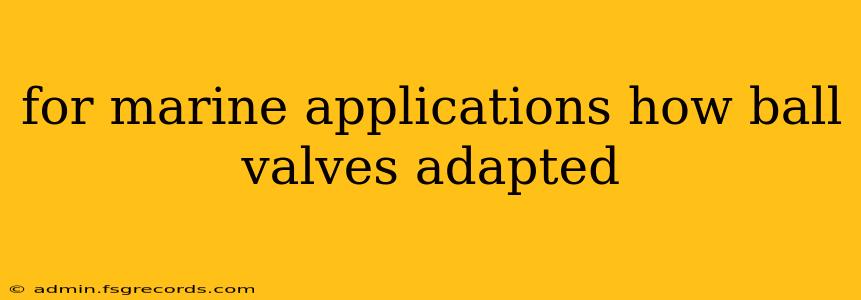Marine environments present unique challenges for any piece of equipment. Saltwater corrosion, extreme temperature fluctuations, and the constant motion of a vessel demand robust and reliable components. Ball valves, with their simple design and inherent strength, have been successfully adapted for marine applications, becoming essential in a variety of onboard systems. This article delves into the specific adaptations that make marine ball valves stand out, focusing on their materials, design features, and certifications.
Material Selection: Combating Corrosion and Degradation
The choice of materials is paramount in ensuring the longevity and performance of marine ball valves. Standard materials used in land-based applications are often insufficient to withstand the harsh marine environment. Therefore, marine-grade ball valves typically employ:
- 316 Stainless Steel: This is a common choice due to its excellent corrosion resistance in saltwater. Its higher molybdenum content compared to standard stainless steel provides superior protection against pitting and crevice corrosion.
- Duplex Stainless Steel: Offering even greater corrosion resistance than 316 stainless steel, duplex stainless steel is often used in high-demand applications or where prolonged exposure to aggressive seawater is expected.
- Super Duplex Stainless Steel: For the most extreme marine environments, super duplex stainless steel offers exceptional strength and resistance to corrosion, chloride pitting, and stress corrosion cracking.
- Special Coatings: In some cases, additional coatings like epoxy or specialized polymer coatings are applied to further enhance corrosion protection and extend the valve's lifespan.
Design Adaptations: Ensuring Reliability and Safety
Beyond material selection, several design modifications enhance the performance and reliability of marine ball valves:
Enhanced Seals:
- High-performance elastomers: Seals made from materials like Viton® or EPDM offer superior resistance to chemicals, high temperatures, and compression set, ensuring a leak-free seal even under pressure and prolonged exposure to seawater.
- Redundant sealing systems: Some marine ball valves incorporate double seals or other redundant systems to provide additional protection against leakage in case of seal failure.
Robust Construction:
- Increased wall thickness: Marine ball valves often feature thicker walls compared to their land-based counterparts to withstand the stresses and pressures encountered at sea.
- Reinforced bodies: In high-pressure applications, the valve body may be reinforced to prevent deformation or failure under pressure.
Improved Actuation:
- Manual operation: While manual operation is common for smaller valves, larger valves often utilize pneumatic or hydraulic actuators for easier and more controlled operation. These actuators are designed to withstand harsh marine conditions.
- Emergency shut-off mechanisms: Safety is paramount. Marine ball valves may incorporate fail-safe mechanisms, ensuring quick closure in emergency situations.
Certifications and Compliance: Meeting Industry Standards
Marine ball valves must meet stringent industry standards and regulations to ensure safety and reliability. Common certifications include:
- ABS (American Bureau of Shipping): A crucial certification for vessels operating internationally.
- DNV GL (Det Norske Veritas Germanischer Lloyd): Another significant classification society, providing certification for various marine equipment.
- LR (Lloyd's Register): A leading classification society offering similar certifications to ABS and DNV GL.
These certifications verify that the valves have met specific performance and safety requirements.
Conclusion: Adaptability for a Demanding Environment
The adaptation of ball valves for marine applications demonstrates the importance of material science and engineering design in creating robust, reliable components for harsh environments. The use of corrosion-resistant materials, enhanced seals, reinforced construction, and adherence to strict industry standards ensures that these valves perform flawlessly, contributing to the safe and efficient operation of vessels worldwide. The careful consideration of these factors makes marine ball valves a critical component in the marine industry's infrastructure.

